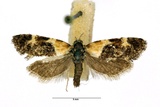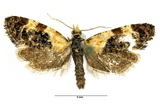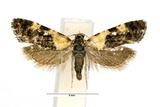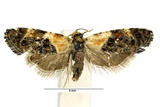Phtheochroa schreibersiana (Frölich, 1828) Species
Last modified: Nov. 22, 2025, 5:08 p.m.
A very rare and local species in Belgium. Nowadays only known from a few observations in the south of the country and a few elsewhere.
Details
- Classification
- Family: Tortricidae > Subfamily: Tortricinae > Tribus: Cochylini > Genus: Phtheochroa > Species: Phtheochroa schreibersiana
- Vernacular names
- Tweekleurig smalsnuitje (NL), Scarce Gold Conch (EN)
- First mention in Belgium
- De Fré Ch. 1858. Catalogue des Microlépidoptères de la Belgique. — Annales de la Société entomologique belge 2: 45–162. On page 97.
- Status
-
Native
Distribution
Imago
Wingspan 11–15 mm. A strikingly marked species. The head, thorax and basal third of the wing are bright cream ochre with a dark tuft and top of the thorax. The remainder of the wing is marked in black and metallic blueish grey. Further is a cream costal mark at three quarters with the wing brown between it and the basal third.
Caterpillar
Pale yellowish brown body, prothoracic plate centrally and along the hind margin darkly punctuated.
Bionomics
The larvae lives in spun leaves at first, then bore in shoots and leaf stalks on the food plant. They hibernate fully fed in a cocoon under bark in which they pupate.
A single brooded species that flies by day but will come to light.
Flight periods
The adults fly in May and June.
Observed on
- Host plant (species):
- Populus nigra and Prunus padus
- Host plant (genera):
- Ulmus
The larvae feed on Ulmus, Populus nigra and Prunus padus.
Habitat
It inhabits hedgerows, fens, marshes, river-banks and other damp areas




